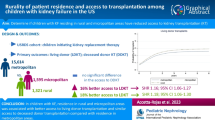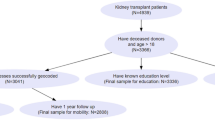Abstract
Background
Low socioeconomic status (SES) and geographic disparity have been associated with worse outcomes and poorer access to pre-emptive transplantation in the adult end-stage kidney disease (ESKD) population, but little is known about their impact in children with ESKD. The aim of our study was to determine whether access to pre-emptive transplantation and transplant outcomes differ according to SES and geographic remoteness in Australia.
Methods
Using data from the Australia and New Zealand Dialysis and Transplant Registry (1993–2012), we compared access to pre-emptive transplantation, the risk of acute rejection and graft failure, based on SES and geographic remoteness among Australian children with ESKD (≤18 years), using adjusted logistic and Cox proportional hazard modelling.
Results
Of the 768 children who commenced renal replacement therapy, 389 (50.5 %) received living donor kidney transplants and 28.5 % of these (111/389) were pre-emptive. There was no significant association between SES quintiles and access to pre-emptive transplantation, acute rejection or allograft failure. Children residing in regional or remote areas were 35 % less likely to receive a pre-emptive transplant compared to those living in major cities [adjusted odds ratio (OR) 0.65, 95 % confidence interval (CI) 0.45–1.0]. There was no significant association between geographic disparity and acute rejection (adjusted OR 1.03, 95 % CI 0.68–1.57) or graft loss (adjusted hazard ratio 1.05, 95 % CI 0.74–1.41).
Conclusions
In Australia, children from regional or remote regions are much less likely to receive pre-emptive kidney transplantation. Strategies such as improved access to nephrology services through expanding the scope of outreach clinics, and support for regional paediatricians to promote early referral may ameliorate this inequity.


Similar content being viewed by others
References
McDonald SP, Craig JC, Australian, New Zealand Paediatric Nephrology A (2004) Long-term survival of children with end-stage renal disease. N Engl J Med 350:2654–2662
Laskin BL, Mitsnefes MM, Dahhou M, Zhang X, Foster BJ (2015) The mortality risk with graft function has decreased among children receiving a first kidney transplant in the United States. Kidney Int 87:575–583
Crittenden MR, Holliday MA, Piel CF, Potter DE (1985) Intellectual development of children with renal insufficiency and end stage disease. Int J Pediatr Nephrol 6:275–280
Groothoff JW, Grootenhuis M, Dommerholt A, Gruppen MP, Offringa M, Heymans HS (2002) Impaired cognition and schooling in adults with end stage renal disease since childhood. Arch Dis Child 87:380–385
Groothoff JW, Grootenhuis MA, Offringa M, Stronks K, Hutten GJ, Heymans HS (2005) Social consequences in adult life of end-stage renal disease in childhood. J Pediatr 146:512–517
Vats AN, Donaldson L, Fine RN, Chavers BM (2000) Pretransplant dialysis status and outcome of renal transplantation in North American Children: a Naprtcs study 12. Transplantation 69:1414–1419
Franke D, Thomas L, Steffens R, Pavičić L, Gellermann J, Froede K, Querfeld U, Haffner D, Živičnjak M (2014) Patterns of growth after kidney transplantation among children with ESRD. Clin J Am Soc Nephrol 10:127–134
Foster BJ, Dahhou M, Zhang X, Platt RW, Hanley JA (2011) Change in mortality risk over time in young kidney transplant recipients. Am J Transplant 11:2432–2442
Smith JM, Martz K, Blydt-Hansen TD (2013) Pediatric kidney transplant practice patterns and outcome benchmarks, 1987–2010: a report of the North American Pediatric Renal Trials and Collaborative Studies. Pediatr Transplant 17:149–157
Patzer RE, Amaral S, Wasse H, Volkova N, Kleinbaum D, McClellan WM (2009) Neighborhood poverty and racial disparities in kidney transplant waitlisting. J Am Soc Nephrol 20:1333–1340
Axelrod DA, Dzebisashvili N, Schnitzler MA, Salvalaggio PR, Segev DL, Gentry SE, Tuttle-Newhall J, Lentine KL (2010) The interplay of socioeconomic status, distance to center, and interdonor service area travel on kidney transplant access and outcomes. Clin J Am Soc Nephrol 5:2276–2288
Gill J, Dong J, Rose C, Johnston O, Landsberg D, Gill J (2013) The effect of race and income on living kidney donation in the United States. J Am Soc Nephrol 24:1872–1879
Gore JL, Danovitch GM, Litwin MS, Pham PT, Singer JS (2009) Disparities in the utilization of live donor renal transplantation. Am J Transplant 9:1124–1133
Keith D, Ashby VB, Port FK, Leichtman AB (2008) Insurance type and minority status associated with large disparities in prelisting dialysis among candidates for kidney transplantation. Clin J Am Soc Nephrol 3:463–470
Grace BS, Clayton PA, Cass A, McDonald SP (2013) Transplantation rates for living- but not deceased-donor kidneys vary with socioeconomic status in Australia. Kidney Int 83:138–145
Satayathum S, Pisoni RL, McCullough KP, Merion RM, Wikstrom B, Levin N, Chen K, Wolfe RA, Goodkin DA, Piera L, Asano Y, Kurokawa K, Fukuhara S, Held PJ, Port FK (2005) Kidney transplantation and wait-listing rates from the international Dialysis Outcomes and Practice Patterns Study (DOPPS). Kidney Int 68:330–337
Goldfarb-Rumyantzev AS, Koford JK, Baird BC, Chelamcharla M, Habib AN, Wang BJ, Lin SJ, Shihab F, Isaacs RB (2006) Role of socioeconomic status in kidney transplant outcome. Clin J Am Soc Nephrol 1:313–322
Patzer RE, Amaral S, Klein M, Kutner N, Perryman JP, Gazmararian JA, McClellan WM (2012) Racial disparities in pediatric access to kidney transplantation: does socioeconomic status play a role? Am J Transplant 12:369–378
Omoloja A, Stolfi A, Mitsnefes M (2006) Racial differences in pediatric renal transplantation-24-year single center experience. J Natl Med Assoc 98:154–157
Patzer RE, Sayed BA, Kutner N, McClellan WM, Amaral S (2013) Racial and ethnic differences in pediatric access to pre-emptive kidney transplantation in the United States. Am J Transplant 13:1769–1781
Tromp WF, Cransberg K, van der Lee JH, Bouts AH, Collard L, Van Damme-Lombaerts R, Godefroid N, Van Hoeck KJ, Koster-Kamphuis L, Lilien MR, Raes A, Ranguelov N, Groothoff JW (2012) Fewer pre-emptive renal transplantations and more rejections in immigrant children compared to native Dutch and Belgian children. Nephrol Dial Transplant 27:2588–2593
Mongeau JG, Clermont MJ, Robitaille P, Plante A, Jequier JC, Godbout C, Guertin MC, Beaulieu MA, Sarrazin F (1997) Study of psychosocial parameters related to the survival rate of renal transplantation in children. Pediatr Nephrol 11:542–546
Oztek FZ, Ipsiroglu O, Mueller T, Aufricht C (2009) Outcome after renal transplantation in children from native and immigrant families in Austria. Eur J Pediatr 168:11–16
Grace BS, Kara T, Kennedy SE, McDonald SP (2014) Racial disparities in pediatric kidney transplantation in New Zealand. Pediatr Transplant 18:689–697
Australian Bureau of Statistics (2006) Australian Standard Geographical Classification 2006. Available at: www.abs.gov.au
Dudley CR, Johnson RJ, Thomas HL, Ravanan R, Ansell D (2009) Factors that influence access to the national renal transplant waiting list. Transplantation 88:96–102
Begaj I, Khosla S, Ray D, Sharif A (2013) Socioeconomic deprivation is independently associated with mortality post kidney transplantation. Kidney Int 84:803–809
Udayaraj U, Ben-Shlomo Y, Roderick P, Casula A, Dudley C, Collett D, Ansell D, Tomson C, Caskey F (2012) Social deprivation, ethnicity, and uptake of living kidney donor transplantation in the United Kingdom. Transplantation 93:610–616
Roodnat JI, Laging M, Massey EK, Kho M, Kal-van Gestel JA, Ijzermans JN, van de Wetering J, Weimar W (2012) Accumulation of unfavorable clinical and socioeconomic factors precludes living donor kidney transplantation. Transplantation 93:518–523
Kasiske BL, Snyder JJ, Matas AJ, Ellison MD, Gill JS, Kausz AT (2002) Preemptive kidney transplantation: the advantage and the advantaged. J Am Soc Nephrol 13:1358–1364
Samuel SM, Hemmelgarn B, Nettel-Aguirre A, Foster B, Soo A, Alexander RT, Tonelli M, Pediatric Renal Outcomes Canada G (2012) Association between residence location and likelihood of transplantation among pediatric dialysis patients. Pediatr Transplant 16:735–741
Alexander G, Sehgal AR (1998) Barriers to cadaveric renal transplantation among blacks, women, and the poor. JAMA 280:1148–1152
Bailey PK, Tomson CR, Ben-Shlomo Y (2013) Study of living kidney donor-recipient relationships: variation with socioeconomic deprivation in the white population of England. Clin Transplant 27:E327–E331
Bendorf A, Pussell BA, Kelly PJ, Kerridge IH (2013) Socioeconomic, demographic and policy comparisons of living and deceased kidney transplantation rates across 53 countries. Nephrology 18:633–640
Furth SL, Garg PP, Neu AM, Hwang W, Fivush BA, Powe NR (2000) Racial differences in access to the kidney transplant waiting list for children and adolescents with end-stage renal disease. Pediatrics 106:756–761
Hall YN, Choi AI, Xu P, O’Hare AM, Chertow GM (2011) Racial ethnic differences in rates and determinants of deceased donor kidney transplantation. J Am Soc Nephrol 22:743–751
Joshi S, Gaynor JJ, Bayers S, Guerra G, Eldefrawy A, Chediak Z, Companioni L, Sageshima J, Chen L, Kupin W, Roth D, Mattiazzi A, Burke GW 3rd, Ciancio G (2013) Disparities among blacks, hispanics, and whites in time from starting dialysis to kidney transplant waitlisting. Transplantation 95:309–318
Kurella-Tamura M, Goldstein BA, Hall YN, Mitani AA, Winkelmayer WC (2014) State medicaid coverage, ESRD incidence, and access to care. J Am Soc Nephrol 25:1321–1329
Nee R, Jindal RM, Little D, Ramsey-Goldman R, Agodoa L, Hurst FP, Abbott KC (2013) Racial differences and income disparities are associated with poor outcomes in kidney transplant recipients with lupus nephritis. Transplantation 95:1471–1478
Jaffa MA, Woolson RF, Lipsitz SR, Baliga PK, Lopes-Virella M, Lackland DT (2010) Analyses of renal outcome following transplantation adjusting for informative right censoring and demographic factors: a longitudinal study. Ren Fail 32:691–698
Chakkera HA, O’Hare AM, Johansen KL, Hynes D, Stroupe K, Colin PM, Chertow GM (2005) Influence of race on kidney transplant outcomes within and outside the Department of Veterans Affairs. J Am Soc Nephrol 16:269–277
Stephens MR, Evans M, Ilham MA, Marsden A, Asderakis A (2010) The influence of socioeconomic deprivation on outcomes following renal transplantation in the United kingdom. Am J Transplant 10:1605–1612
Lentine KL, Schnitzler MA, Xiao H, Saab G, Salvalaggio PR, Axelrod D, Davis CL, Abbott KC, Brennan DC (2010) Racial variation in medical outcomes among living kidney donors. N Engl J Med 363:724–732
Tanriover B, Stone PW, Mohan S, Cohen DJ, Gaston RS (2013) Future of medicare immunosuppressive drug coverage for kidney transplant recipients in the United States. Clin J Am Soc Nephrol 8:1258–1266
Patzer RE, Mohan S, Kutner N, McClellan WM, Amaral S (2015) Racial and ethnic disparities in pediatric renal allograft survival in the United States. Kidney Int 87:584–592
Ragupathy R, Aaltonen K, Tordoff J, Norris P, Reith D (2012) A 3-dimensional view of access to licensed and subsidized medicines under single-payer systems in the US, the UK, Australia and New Zealand. Pharmacoeconomics 30:1051–1065
Glover J, Rosman D, Tennant S (2004) Unpacking analyses relying on area-based data: are the assumptions supportable? Int J Health Geogr 3:30
Author contributions
AF participated in the writing of the paper and data analysis, MD, SK and JCC participated in the writing of the paper, WHL participated in research design and the writing of the paper, and GW participated in research design, the performance of the research, data analyses and the writing of the paper
Author information
Authors and Affiliations
Corresponding author
Ethics declarations
Compliance with ethical standards
Due to the retrospective nature of this study neither individual parental consent nor internal review board approval were required
Conflict of interest
The authors declare no conflicts of interest.
Electronic supplementary material
Below is the link to the electronic supplementary material.
ESM 1
(DOCX 58.5 kb)
Rights and permissions
About this article
Cite this article
Francis, A., Didsbury, M., Lim, W.H. et al. The impact of socioeconomic status and geographic remoteness on access to pre-emptive kidney transplantation and transplant outcomes among children. Pediatr Nephrol 31, 1011–1019 (2016). https://doi.org/10.1007/s00467-015-3279-z
Received:
Revised:
Accepted:
Published:
Issue Date:
DOI: https://doi.org/10.1007/s00467-015-3279-z




